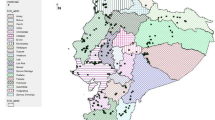Abstract
The sweet potato genebank at the International Potato Center (CIP) maintains 5,526 cultivated I. batatas accessions from 57 countries. Knowledge of the genetic structure in this collection is essential for rational germplasm conservation and utilization. Sixty-nine sweet potato cultivars from 4 geographical regions (including 13 countries) of Latin America were randomly sampled and fingerprinted using AFLP markers. A total of 210 polymorphic and clearly scorable fragments were generated. A geographic pattern of diversity distribution was revealed by mean similarity, multidimensional scaling (MDS), and analysis of molecular variance (AMOVA). The highest genetic diversity was found in Central America, whereas the lowest was in Peru-Ecuador. The within-region variation was the major source of molecular variance. The between-regions variation, although it only explains 10.0% of the total diversity, is statistically significant. Cultivars from Peru-Ecuador, with the lowest level of within region diversity, made the most significant contribution to the between region differentiation. These results support the hypothesis that Central America is the primary center of diversity and most likely the center of origin of sweet potato. Peru-Ecuador should be considered as a secondary center of sweet potato diversity.
Similar content being viewed by others
References
Armstrong, I., A. Gibbs, R. Peakall & G. Weiller, 1995. RAP-Distance, Package Manual. Version 1.03. Australian National University, Canberra.
Austin, D.F., 1983. Variability in sweetpotatoes in America. Proc. Amer. Soc. Hort. Sci. 27 (pt. B): 15–26.
Austin, D.F., 1988. The taxonomy, evolution and genetic diversity of sweetpotatoes and related wild species, In: P. Gregory (Ed.), Exploration, maintenance, and utilization of sweetpotato genetic resources, pp. 27-60. Intl. Potato Ctr., Lima, Peru.
Brown, A.H.D., 1989. Core collection: A practical approach to genetic resources management. Genome 31: 818-824.
Doyle, J.J. & J.L. Doyle, 1990. Isolation of plant DNA from fresh tissue. Focus 12: 13-15.
Excoffier, L. & P.E. Smouse, 1994. Using allele frequencies and geographic subdivision to reconstruct gene trees within a species: molecular variance parsimony. Genetics 136: 343-359.
Excoffier, L, P.E. Smouse & J.M. Quattro, 1992. Analysis of molecular variance inferred from metric distances among DNA haplotypes: applications to human mitochondria DNA restriction data. Genetics 131: 479-491.
Engel, E., 1970. Exploration of the Chilca Canyon. Current Anthropol. 11: 55-58.
Ghislain, M., D.P. Zhang, D. Fajardo, Z. Huamán & R.J. Hijmans, 1999. Marker-assisted sampling of the cultivated Andean potato Solanum phureja collection using RAPD markers. Genet. Resour. Crop Evol. 46: 547-555.
Huamán, Z. & D.P. Zhang, 1997. Sweetpotato. In: D. Fuccillo et al. (Eds), Biodiversity in Trust-Conservation and Use of Plant Genetic Resources in CGIAR Centers, pp. 29-38. Cambridge University Press, Cambridge, UK.
International Potato Center (CIP), 1998. Sweetpotato facts. International Potato Center, Lima, Peru.
Jarret, R.L. & D.F. Austin, 1994. Genetic diversity and systematic relationships in sweetpotato (Ipomoea batatas (L.) Lam.) and related species as revealed by RAPD analysis. Genet. Resour. Crop Evol. 41: 165-173.
O'Brien, P.J., 1972. The sweetpotato: its origin and dispersal. Am. Anthropologist 74: 343-365.
SAS Institute, 1997. SAS/STAT Software: Changes and Enhancements through Release 6.12. SAS Inst. Inc., Cary, N.C.
Sneath, P.H.A. & R.R. Sokal, 1973. Numerical taxonomy. The principles and practice of numerical classification. W.H. Freeman, San Francisco.
Urgent, D. & L. Peterson, 1988. Archeological remains of potato and sweetpotato in Peru. CIP Circular 16 (3): 1-10.
Vos, P., R. Hogers, M. Bleeker, M. Reijans, T. van der Lee, M. Hornes, A. Frijters, J. Pot, J. Peleman, M. Kuiper & M. Zabeau, 1995. AFLP: a new technique for DNA fingerprinting. Nuc. Ac. Res. 23: 4407-4414.
Woolfe, J., 1992. Sweetpotato, an untapped food resource. Cambridge University Press, Cambridge, England.
Yen, D.E., 1974. The sweetpotato and Oceania. Bishop Museum Bull., Honolulu 236: 1-389.
Yen, D.E., 1982. Sweetpotato in historical perspective. In: R.L. Villareal & T.D. Griggs (Eds.), SweetPotato, Proceedings of First International Symposium, pp. 17-3O. AVRDC Publ. No. 82-172, Tainan, Taiwan, China.
Yonesawa, Y., T. Nomura & H. Morishima, 1995. Sampling strategies for use in stratified germplasm collections, In: T. Hodgkin, A.H.D. Brown, Th.J.L. Van Hintum & E.A.V. Morales Eds.), Core Collections of Plant Genetic Resources, pp. 35-54. John Willey & Sons, Chichester.
Zhang, D.P., M. Ghislain, Z. Huamán, A. Golmirzaie & R.J. Hijmans, 1998. RAPD variation in sweetpotato [Ipomoea batatas (L.) Lam. cultivars from South America and Papua New Guinea. Genet. Resour. Crop Evol. 45: 271-277.
Rights and permissions
About this article
Cite this article
Zhang, D., Cervantes, J., Huamán, Z. et al. Assessing genetic diversity of sweet potato (Ipomoea batatas (L.) Lam.) cultivars from tropical America using AFLP. Genetic Resources and Crop Evolution 47, 659–665 (2000). https://doi.org/10.1023/A:1026520507223
Issue Date:
DOI: https://doi.org/10.1023/A:1026520507223




